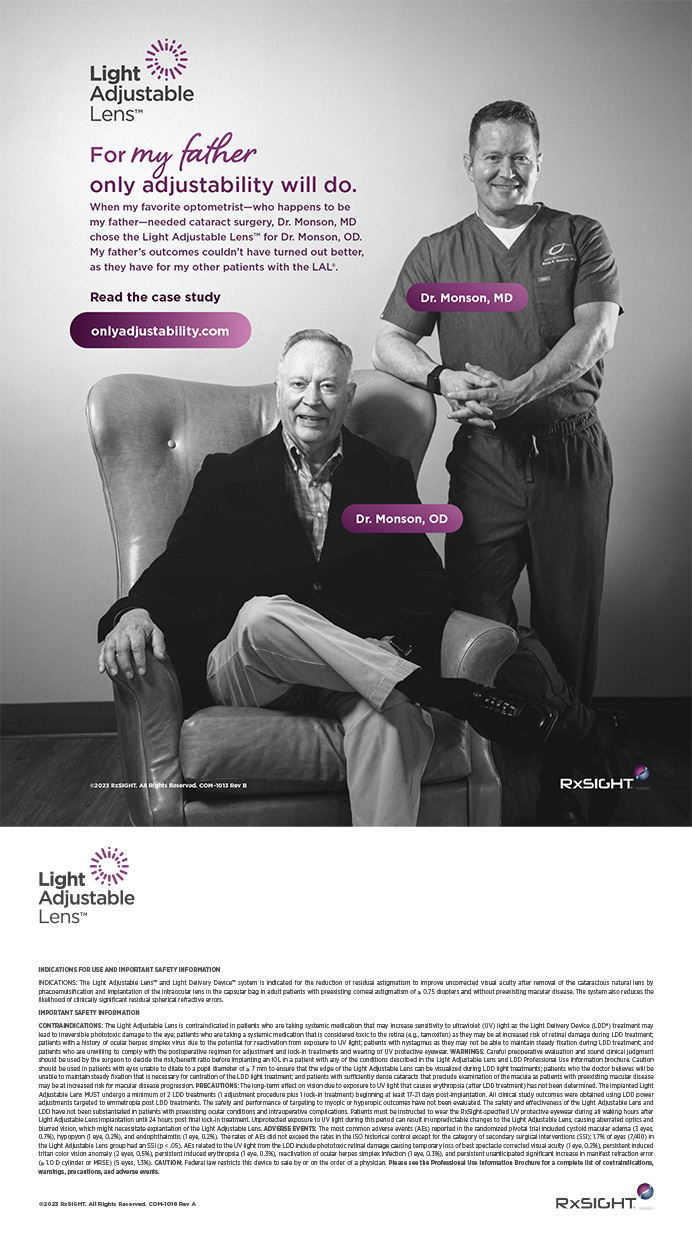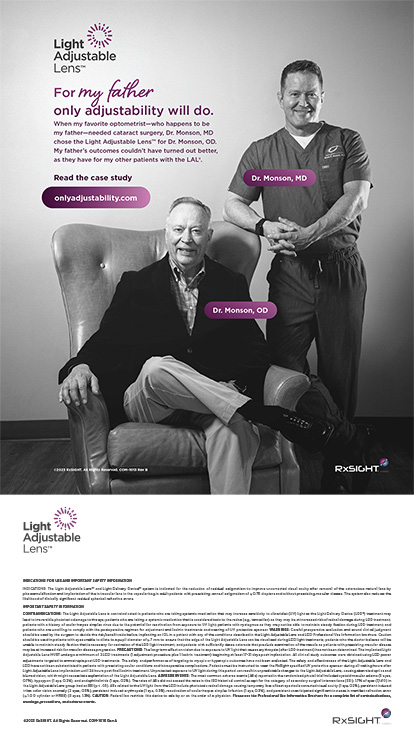Clinical Case No. 1
A 34-year-old junior executive travels to China on a 10-day business trip. He wears soft 2-week contact lenses but, due to an intense work schedule, exhibits poor contact lens maintenance and hygiene. His right eye becomes red and painful on his fifth day overseas, and he develops severe conjunctivitis, as diagnosed by the hotel's doctor. The patient is given a box of eye drops. He self-medicates with old artificial tears that he has in his bag and uses cool tap water to rinse his eye. He also shares contact lens solution with colleagues. One week later, on his return to the United States, the patient presents to our clinic with multiple infiltrates and hypopyon of the right eye.
Clinical Case No. 2
An 18-year-old college sophomore is on a humanitarian mission in Costa Rica with her classmates and sustains a corneal scratch. She applies some local tap water and then contact lens solution, after which she replaces her contact lens. Three days later, she is transported to a local ophthalmologist with ocular pain that is far worse than for a corneal scratch; she is diagnosed with a ring ulcer of her left eye. The patient is started on a local pharmacy's acid solution and told to return to the United States as soon as possible.
—Cases prepared by Jai G. Parekh, MD, MBA.
Although the incidence of contact lens-associated keratitis is relatively low in the United States, keratitis is a major cause of blindness, second only to cataracts, in developing countries.1,2 Patient populations at increased risk of developing contact lens-related microbial keratitis include people whose contact lens hygiene is poor, those who are new to wearing contact lenses, young patients, smokers, immuno-compromised patients, those of high socioeconomic status, and patients traveling to warm, tropical regions.1,3,4
China and India have a high burden of disease.5,6 In Asia, the most frequent culprits of contact lens-associated keratitis are Pseudomonas and fungus. These infections are associated with poor outcomes due to a delay in diagnosis and difficulty controlling these bacteria with topical treatments.5,7 Contact lens-associated keratitis acquired during travel (especially international travel, where there is a different spectrum of infective flora and differing resistance patterns) presents higher morbidity risks due to patients' limited access to ophthalmic care abroad, thereby leading to a delay in treatment and a poorer prognosis and outcomes.8
SURVEY OF A HIGH-RISK GROUP
In order to further understand the relationship between contact lens use, travel, and contact lens-associated keratitis, we surveyed college students in the United States. This age group represents one of the populations at highest risk of developing contact lens-related eye infections.7 Of the 107 respondents, 55 students had never worn contact lenses, and 52 wore contact lenses. Of the 52 students who wore contact lenses, 17 students used daily wear, 16 used biweekly wear, and 19 used monthly wear contact lenses. Of the 52 students who wore contact lenses, 26 said that they had had an infection related to contact lens use (Figure).
We also asked the students about their travel habits over the past 2 years. Of the 108 respondents, 65 had traveled five times or more, 10 had traveled four times, 18 had traveled three times, eight had traveled twice, three had traveled once, and only three students had not traveled at all. Of the 104 students who had traveled, 70 students had gone outside the United States, and 34 students had stayed within the country.
LACK OF GUIDELINES
We conducted a review of the guidelines for safe contact lens use put forth by the American Academy of Ophthalmology,1 the Contact Lens Association of Ophthalmologists,9 the Centers for Disease Control,10and the FDA.11 We also searched for preventive and educational care guidelines with regard to travel. The guidelines from the aforementioned organizations caution patients to appropriately clean and disinfect their contact lenses as well as to discard them according to the prescribed duration of use. They offer no specific recommendations, however, regarding precautions patients must take when traveling internationally. Furthermore, the guidelines do not warn of a potentially higher risk of keratitis with poor outcomes due to conditions abroad, the prevalence of certain infectious microbes in particular areas, and increased likelihood of delay in treatment.12
A NEW CATEGORY OF INFECTIONS
In recognition of the incidence and severity of keratitis associated with contact lens use during travel, we propose categorizing these infections as traveler's contact lens-associated keratitis (TCLAK). Patients with infectious keratitis, including TCLAK, are at increased risk of dire outcomes such as corneal scarring, vision loss, and potential need for corneal transplantation due to the likely delay in treatment.13
We believe it essential to recognize TCLAK infections as a group, to develop preventive guidelines for patients, and to create clinical care guidelines for providers. Our efforts in this regard appear in the sidebar (see Guidelines on TCLAK for Patients). We strongly recommend that eye care providers share these guidelines with their patients who wear contact lenses, especially those who travel. As part of the discussion, practitioners should explain to their patients the importance of following the guidelines; research has shown that patients often have the information on how to care for their contact lenses but do not model those behaviors if they do not understand the reason for them.14
Guidelines on TCLAK for Patients1
By Jai G. Parekh, MD, MBA
- Speak to your eye care provider before international travel regarding contact lens hygiene and overall eye health.
- Identify an eye care provider to contact if needed while traveling.
- If traveling to a remote area and/or if you have difficulty identifying an eye care provider in the region where you will be traveling, be sure to take along a bottle of brand-name artificial tears, and consider obtaining and filling a prescription for broad-spectrum antibiotic eye drops prior to departure in the event an eye infection develops, especially if you have a history of keratitis. If you contract an infection while traveling, see an eye care provider immediately to assist with the diagnosis and usage of eye drops.
- Use prescription eye glasses when traveling. Wear them as much as possible, including on flights where the air quality is diminished.
- Closely adhere to a well-defined schedule for contact lens wear and hygiene.
- Consider decreasing the duration of daily contact lens use when traveling as well as complete abstinence from overnight contact lens wear.
- Favor daily, 1-day disposable contact lens wear.
- Minimize your exposure to swimming pools and the ocean. When in the water, wear tight swimming goggles.
- Remove your contact lenses immediately if any signs or symptoms of irritation or infection such as red eyes, eye pain, difficulty seeing, light sensitivity, eyelid swelling, or discharge occur.
- If eye symptoms are limited to red eye and/or itching, discontinue contact lens wear, and initiate use of artificial tears. If the symptoms worsen or do not improve within 24 hours, seek out an eye care provider.
- If eye symptoms include a painful red eye, difficulty seeing, light sensitivity, and/or eyelid swelling, discontinue contact lens wear, and seek eye care within 24 hours. If your eye doctor prescribed an antibiotic eye drop prior to your departure, begin using it, empirically, according to the instructions.
- Avoid water from the tap for cleaning your contact lenses or rinsing your eyes. Biological, infectious, or chemical contaminants may make the water unsafe.
- If you develop an eye infection, keep your contact lenses, solution, and case. These items can be cultured upon your return home, which is important, because some of the bacteria and fungus that cause eye infections differ by geographic location. This may aid in the treatment of your eye condition.
- If your eye becomes infected while your are traveling, visit your eye care provider within 24 hours of your return to the United States for further intervention, including an eye examination, corneal culture, and appropriate treatment.
- Ukpe FF, Youlios SA, Parekh BJ, Parekh JG. Traveler's contact lens associated keratitis (TCLAK): establishing preventive and treatment guidelines to close a gap in ophthalmic care. Poster presented at: The Association for Research in Vision and Ophthalmology Annual Meeting; May 2013; Seattle, WA.
Bela J. Parekh is a high-school senior at the Kent Place School in Summit, New Jersey, and a research assistant at Brar-Parekh Eye Associates in Woodland Park, New Jersey. Ms. Parekh may be reached at (973) 785-2050; parekhb14@kentplace.org .
Jai G. Parekh, MD, MBA, is the managing partner at Brar-Parekh Eye Associates in Woodland Park, New Jersey, and chief of cornea and external diseases/chief of the Research Institute at St. Joseph's HealthCare System, located in Wayne/Paterson, New Jersey. Dr. Parekh is also a clinical associate professor of ophthalmology on the Cornea Service at the New York Eye & Ear Infirmary in New York City. Dr. Parekh may be reached at (973) 785-2050; kerajai@gmail.com .
F. Fallon Ukpe, MD, MBA, is a management consultant. Dr. Ukpe may be reached at (832) 618-9752; fallon.ukpe@gmail.com
Stephanie A. Youlios, BS, is a research assistant at Brar-Parekh Eye Associates in Woodland Park, New Jersey. Ms. Youlios may be reached at (973) 785-2050; stephyoulios@gmail.com
- American Academy of Ophthalmology. Preferred Practice Pattern Guideline. Bacterial keratitis PPP. Limited Revision. http://one.aao.org/preferred-practice-pattern/bacterial-keratitis-ppp--limitedrevision- october Published October 2011. Accessed October 3, 2013.
- Whitcher JP, Srinivasan M, Upadhyay MP. Corneal blindness: a global perspective. Bull World Health Organ. 2001;79(3):214-221.
- Levy B. Infectious keratitis: what have we learned? Eye Contact Lens. 2007;33(6 pt 2):418-420.
- Zaigraykina N, Tomkins O, Garzozi HJ, Potasman I. Fusarium keratitis acquired during travel to Namibia. J Travel Med. 2010;17(3):209-211.
- Tan D. Early results of the Asia Cornea Society Infectious Keratitis Study (ACSIKS). Paper presented at: The 3rd Asia Cornea Society Scientific Meeting; November 28, 2012; Manila, Philippines.
- Nagachandrika T, Kumar U, Dumpati S, et al. Prevalence of contact lens related complications in a tertiary eye centre in India. Cont Lens Anterior Eye. 2011;34(6):266-268.
- LeBoyer RM, Soong HK. Complications of contact lenses. UpToDate. Waltham, MA. Published 2011. http://www.uptodate.com/contents/complications-of-contact-lenses. Accessed October 4, 2013.
- Donzis PB. Corneal ulcers from contact lenses during travel to remote areas. N Engl J Med. 1998;338:1629-1630.
- Contact Lens Association of Ophthalmologists, Inc. http://www.clao.org.. Accessed July 22, 2013.
- Centers for Disease Control and Prevention. Protect your eyes: health and safe contact lens use. http://www.cdc.gov/contactlenses. Accessed July 22, 2013..
- United States Food and Drug Administration. Contact lenses. http://www.fda.gov/MedicalDevices/ ProductsandMedicalProcedures/HomeHealthandConsumer/ConsumerProducts/ContactLenses/default.htm. Accessed July 22, 2013.
- Stapleton F, Keay LJ, Sanfilippo PG, et al. Relationship between climate, disease severity, and causative organism for contact lens-associated microbial keratitis in Australia. Am J Ophthalmol. 2007;144(5):690-698.
- Murillo-Lopez FH, Bacterial keratitis. Medscape. http://emedicine.medscape.com/article/1194028-overview Published April 12, 2012. Accessed October 13 2013.
- Robertson DM, Cavanagh HD. Non-compliance with contact lens wear and care practices: a comparative analysis. Optom Vis Sci. 2011;88(12):1402-1408.


